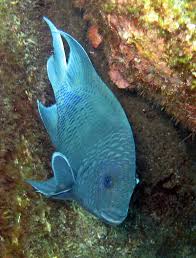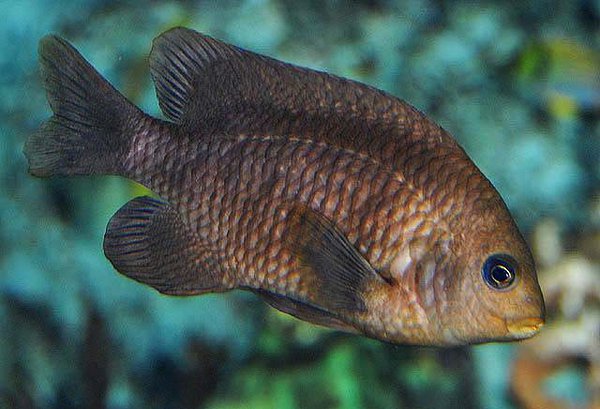Damsels in Distress!
Damselfish are found in many shapes and sizes and are a big part of the reef fish community, here in La Paz we have many different species and they like to make themselves known to divers...
During my dives this week I noticed many of the damselfish were displaying slightly different behaviour than usual - some of them seemed a little more aggressive and there was also some nice dancing occuring in their reef patches. Upon closer inspection it seems that this is due to a lot of mating going on right now.
Who are the damselfish? Damselfish are generally quite small, most being 2-5 inches in size, but diving in La Paz it is not uncommon to see the Giant Damselfish (with that name nit surprisingly the largest damselfish in the gulf!) which can grow up to 12 inches. Many species of damsels spend their day busily tending and patrolling around a specific area of the reef - the reason for this is that they feed mainly on algae that grows on the rocks or reef. Damselfish act as farmers on the reef and they maintain their patch, when their farmland is threatened by other fish, divers or snorkellers coming too close then they have no qualms about defending it. I've had these little blighters come up to my faces and dart around my mask and sometimes seem to nip at my wetsuit!
This week the three damselfish which most caught my eye were the giant, panamic sergeant major and cortez damselfish.
Giant Damselfish - Always a favourite of mine to see on a dive because their size makes them so distinctive and they are a beautiful shade of petrol blue. This week I saw many that had changed their colouration and were displaying a silvery grey, almost white head and so looked completely bicoloured. This is an identifying feature of breeding males and so when I see these colours around I know to look closely for patches of eggs that they may be guarding. When the male is bicoloured like this there is often a female lurking nearby as they will form pairs during the breeding season. Lots of them were seen at Punta Lobos this week.
Panamic Sergeant Major - I have found sergeant major fish all over the world from the Bahamas to here in the Sea of Cortez. They are vary distinctive and not easily confused with any other member of the damselfish family because they have a very distinctive black and white barred pattern with a yellow wash on top of their backs. When diving Swanne reef just yesterday I saw many of them with a bluish tint to their bodies, then I looked closer at the rocks - many of them were purple! The purple coating on the rocks is the eggs of the sergeant majors, I saw a normal coloured sergeant major come up to the rocks and rub herself all over it, like a dog in a particularly fine smelling patch of grass, then the male would come by and repeat the action. During breeding season the females will leave their territory and go over to the male, he has changed into his finest threads by taking on this blueish sheen to help attract the female. When rubbing herself on the rock the female is depositing her eggs, they stick to the rock and then the male can come along and fertilise them. The males then guard the eggs and constantly swim over them to help keep them aerated. During this time of year they are seen closer to the rocks and reef surface but besides feeding on benthic algae they do also feed on plankton in the water column. I often see them near the surface particulary around Los Islotes.
Cortez Damselfish - The drabest of the three it is easy to not pay too much attention to the cortez damselfish as unless you see the juveniles (which are a beautiful brilliant blue) they are brown in colour usually with a few white spots or patches. However to not give them some attention would be a disservice as they are quite the interesting critter. Like the other damsels the Cortez lays eggs on the bottom substrate and then the male will fetilize and guard the eggs. These males take it one step further and engage in filial cannibalism! Filial cannibalism is where the adult of a species eats all or some of its offspring. Male Cortez damsels have been found to typically consume about 25% of the clutch they are guarding! The males tend to eat the ones that are smaller in size and in the early stages of development. Females therefore prefer to lay their eggs with males who are looking after other in the early stage and not in the late stages of development. So if you have gone to all the trouble of finding a mate and caring for the babies then why at them? It is thought that the males eat the eggs for a variety of reasons:
1) It satisfies their hunger - eggs are rich in nutrients and energy.
2) If the reproductive environment is not at an optimum then it is a way for the male to regain some of the energy that was invested into eggs which are unlikely to survive anyway.
3) It puts evolutionary pressure on the offspring to make them develop faster.
4) It removes offspring that are taking too long to mature and requiring too much care.
5) It removes any weaker young particularly if it is a large brood of eggs, thus making chances of success for the others greater.
However cannibalism does come at a price it may lead to a loss of fitness, transmission of disease and parasites and leads to a reduction in brood size, not to mention the emotional distress!
So next time you go for a dive make sure you watch the animal behaviour, it gives us a greater insight into their lives and means that you can learn about and enjoy the underwater environment even more.
No camera on my dives this week so photos courtesy of google.
Who are the damselfish? Damselfish are generally quite small, most being 2-5 inches in size, but diving in La Paz it is not uncommon to see the Giant Damselfish (with that name nit surprisingly the largest damselfish in the gulf!) which can grow up to 12 inches. Many species of damsels spend their day busily tending and patrolling around a specific area of the reef - the reason for this is that they feed mainly on algae that grows on the rocks or reef. Damselfish act as farmers on the reef and they maintain their patch, when their farmland is threatened by other fish, divers or snorkellers coming too close then they have no qualms about defending it. I've had these little blighters come up to my faces and dart around my mask and sometimes seem to nip at my wetsuit!
This week the three damselfish which most caught my eye were the giant, panamic sergeant major and cortez damselfish.
Giant Damselfish - Always a favourite of mine to see on a dive because their size makes them so distinctive and they are a beautiful shade of petrol blue. This week I saw many that had changed their colouration and were displaying a silvery grey, almost white head and so looked completely bicoloured. This is an identifying feature of breeding males and so when I see these colours around I know to look closely for patches of eggs that they may be guarding. When the male is bicoloured like this there is often a female lurking nearby as they will form pairs during the breeding season. Lots of them were seen at Punta Lobos this week.
Panamic Sergeant Major - I have found sergeant major fish all over the world from the Bahamas to here in the Sea of Cortez. They are vary distinctive and not easily confused with any other member of the damselfish family because they have a very distinctive black and white barred pattern with a yellow wash on top of their backs. When diving Swanne reef just yesterday I saw many of them with a bluish tint to their bodies, then I looked closer at the rocks - many of them were purple! The purple coating on the rocks is the eggs of the sergeant majors, I saw a normal coloured sergeant major come up to the rocks and rub herself all over it, like a dog in a particularly fine smelling patch of grass, then the male would come by and repeat the action. During breeding season the females will leave their territory and go over to the male, he has changed into his finest threads by taking on this blueish sheen to help attract the female. When rubbing herself on the rock the female is depositing her eggs, they stick to the rock and then the male can come along and fertilise them. The males then guard the eggs and constantly swim over them to help keep them aerated. During this time of year they are seen closer to the rocks and reef surface but besides feeding on benthic algae they do also feed on plankton in the water column. I often see them near the surface particulary around Los Islotes.
Cortez Damselfish - The drabest of the three it is easy to not pay too much attention to the cortez damselfish as unless you see the juveniles (which are a beautiful brilliant blue) they are brown in colour usually with a few white spots or patches. However to not give them some attention would be a disservice as they are quite the interesting critter. Like the other damsels the Cortez lays eggs on the bottom substrate and then the male will fetilize and guard the eggs. These males take it one step further and engage in filial cannibalism! Filial cannibalism is where the adult of a species eats all or some of its offspring. Male Cortez damsels have been found to typically consume about 25% of the clutch they are guarding! The males tend to eat the ones that are smaller in size and in the early stages of development. Females therefore prefer to lay their eggs with males who are looking after other in the early stage and not in the late stages of development. So if you have gone to all the trouble of finding a mate and caring for the babies then why at them? It is thought that the males eat the eggs for a variety of reasons:
1) It satisfies their hunger - eggs are rich in nutrients and energy.
2) If the reproductive environment is not at an optimum then it is a way for the male to regain some of the energy that was invested into eggs which are unlikely to survive anyway.
3) It puts evolutionary pressure on the offspring to make them develop faster.
4) It removes offspring that are taking too long to mature and requiring too much care.
5) It removes any weaker young particularly if it is a large brood of eggs, thus making chances of success for the others greater.
However cannibalism does come at a price it may lead to a loss of fitness, transmission of disease and parasites and leads to a reduction in brood size, not to mention the emotional distress!
So next time you go for a dive make sure you watch the animal behaviour, it gives us a greater insight into their lives and means that you can learn about and enjoy the underwater environment even more.
No camera on my dives this week so photos courtesy of google.

